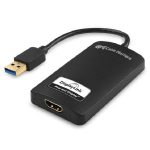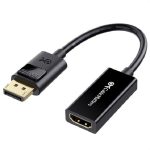In our increasingly digital world, HDMI cables are the unsung heroes that connect our devices, bringing movies to life on our TVs, extending our computer displays, and enhancing our gaming experiences. However, like any piece of technology, HDMI cables can experience wear and tear or even malfunction, leading to frustrating disruptions. Recognizing the symptoms of a bad HDMI cable is crucial for troubleshooting and restoring your seamless viewing or gaming pleasure. Let’s delve into the common signs that your HDMI cable might be the culprit behind those connection woes.
Contents
- 1 Visual Disruptions: When the Picture Goes Awry
- 2 Audio Anomalies: When the Sound Stutters or Disappears
- 3 Connection Instability: The Unreliable Link
- 4 Physical Damage: Visible Signs of Trouble
- 5 Troubleshooting Tips: Before Replacing the Cable
- 6 Beyond the Obvious: Less Common Symptoms
- 7 The Importance of Cable Quality and Length
- 8 DIY Repairs: Proceed with Caution
- 9 The Environmental Impact: Proper Disposal
- 10 Conclusion: Embrace Seamless Connectivity
Visual Disruptions: When the Picture Goes Awry
One of the most telltale signs of a faulty HDMI cable lies in visual disruptions that affect the quality of the image displayed on your screen.
- Flickering or Intermittent Picture: A bad HDMI cable can cause the picture to flicker or cut in and out sporadically. This can be particularly frustrating during action-packed scenes or intense gaming moments.
- Snow or “Sparkles” on the Screen: You might notice a snowy or grainy appearance on the screen, often accompanied by tiny white or colored dots, commonly referred to as “sparkles.” This indicates a disrupted signal transmission.
- Blackouts or Signal Loss: In some cases, a faulty HDMI cable can cause complete signal loss, resulting in a blank screen or an error message like “No Signal.”
- Color Distortion or Fading: If colors appear inaccurate, faded, or washed out, it could be a sign of a damaged HDMI cable hindering the transmission of color data.
- Blurry or Fuzzy Picture: A bad HDMI cable can also cause a blurry or fuzzy picture, making it difficult to distinguish details on the screen.
Audio Anomalies: When the Sound Stutters or Disappears
HDMI cables carry both video and audio signals. So, if you’re experiencing audio issues, a faulty HDMI cable could be the underlying cause.
- Audio Dropouts or Intermittent Sound: You might experience moments of silence or audio cuts where the sound completely disappears or stutters, disrupting your viewing or gaming experience.
- Crackling or Popping Noises: A bad HDMI cable can introduce crackling, popping, or static noises into the audio output, creating an unpleasant listening experience.
- Out-of-Sync Audio: If the audio is not synchronized with the video, it could indicate a problem with the HDMI cable’s signal transmission.
Connection Instability: The Unreliable Link
A faulty HDMI cable can create an unstable connection between your devices, leading to frustrating interruptions and inconsistencies.
- Frequent Disconnections: The connection might drop unexpectedly, forcing you to reconnect the cable or restart your devices repeatedly.
- “No Signal” or “Unsupported Format” Errors: These error messages can appear on your screen, indicating a communication breakdown between your devices due to a faulty cable.
- Difficulty Establishing a Connection: You might experience difficulties getting your devices to recognize each other or establish a stable connection initially.

Physical Damage: Visible Signs of Trouble
Sometimes, a simple visual inspection of your HDMI cable can reveal signs of damage that might be causing the connection problems.
Frayed or Exposed Wires
Check both ends of the cable for frayed or exposed wires, which can interfere with signal transmission and pose a safety hazard.
Bent or Damaged Connectors
Inspect the HDMI connectors for any bends, cracks, or broken pins, which can hinder proper connection.
Kinks or Twists in the Cable
Avoid excessive bending or twisting of the cable, as this can damage the internal wires and disrupt signal flow.
Troubleshooting Tips: Before Replacing the Cable
Before you rush to replace your HDMI cable, try these troubleshooting steps to pinpoint the issue:
- Check Connections: Ensure the HDMI cable is securely plugged into both your source device (e.g., gaming console, Blu-ray player) and display device (e.g., TV, monitor).
- Try a Different Cable: If you have another HDMI cable handy, try swapping it out to see if the problem persists. This will help determine if the cable is indeed the culprit.
- Try Different Ports: Connect the HDMI cable to different HDMI ports on both devices to rule out any issues with specific ports.
- Restart Your Devices: Sometimes, a simple restart can resolve minor connection glitches.
- Update Firmware or Drivers: Ensure your devices have the latest firmware or driver updates, as outdated software can sometimes cause compatibility issues.
HDMI cables are essential for connecting our devices and enjoying high-quality audio and video experiences. However, when a cable malfunctions, it can disrupt our entertainment and productivity. By recognizing the common symptoms of a bad HDMI cable and following the troubleshooting tips provided, you can identify the issue and take appropriate action. Whether it’s replacing the cable or exploring other solutions, addressing the problem promptly will ensure a seamless and enjoyable viewing or gaming experience.
Beyond the Obvious: Less Common Symptoms
While the visual and audio disruptions mentioned earlier are the most prevalent signs of a bad HDMI cable, there are a few less common symptoms that can also indicate trouble brewing.
- Interference from Other Devices: If you notice intermittent connection issues or picture quality fluctuations when certain devices are nearby or in use, it could indicate interference impacting your HDMI cable’s signal transmission. This is more common with older or lower quality cables that might not have proper shielding.
- Slow Response Time or Lag: In gaming or interactive applications, a bad HDMI cable can cause noticeable lag or delay between your actions and the on-screen response. This can significantly impact your gameplay and overall experience.
- Inconsistent Behavior: Sometimes, a faulty HDMI cable might work perfectly fine for a while, only to exhibit issues intermittently. This inconsistency can be frustrating and difficult to diagnose, but it often points to a problem within the cable itself.

The Importance of Cable Quality and Length
The quality and length of your HDMI cable can also influence its performance and lifespan.
- Cable Quality: Investing in a high-quality HDMI cable from a reputable brand can significantly reduce the risk of connection problems. Look for cables with gold-plated connectors, proper shielding, and adequate bandwidth to support your devices’ resolutions and features.
- Cable Length: The longer the HDMI cable, the higher the chance of signal degradation or loss. If you need a longer cable, consider using an HDMI extender or repeater to boost the signal and maintain optimal performance.
DIY Repairs: Proceed with Caution
While some minor repairs can be attempted on damaged HDMI cables, it’s generally recommended to replace them altogether. Attempting repairs on internal wiring or connectors can be complex and might not offer a long-term solution.
- Replacing Connectors: If the issue lies solely with a damaged connector, replacing it with a new one might be feasible. However, this requires soldering skills and proper tools.
- Fixing External Damage: Minor external damage like a frayed outer layer can sometimes be addressed with electrical tape or heat shrink tubing. However, this is only a temporary fix and might not fully resolve the issue.
The Environmental Impact: Proper Disposal
When replacing a faulty HDMI cable, it’s crucial to dispose of it responsibly. Electronic waste can contain harmful materials that can leach into the environment if not handled correctly.
- E-Waste Recycling Centers: Many communities have e-waste recycling centers or drop-off locations where you can safely dispose of old electronics, including HDMI cables.
- Manufacturer Take-Back Programs: Some electronics manufacturers offer take-back programs for their products, including cables. Check with the manufacturer of your device or cable to see if they have such a program.

Conclusion: Embrace Seamless Connectivity
HDMI cables are the backbone of our digital entertainment and productivity setups. By understanding the symptoms of a bad HDMI cable, you can proactively troubleshoot issues and restore your seamless viewing or gaming experience. Remember, investing in a high-quality cable and handling it with care can prevent future headaches and ensure optimal performance for years to come.
So, the next time you encounter a flickering picture, audio dropout, or connection instability, don’t let a faulty HDMI cable spoil your fun. Take action, troubleshoot the problem, and enjoy uninterrupted connectivity!


